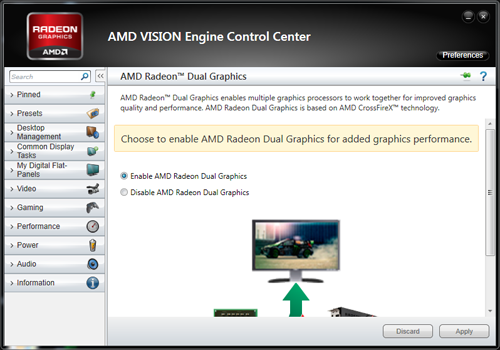Dual Graphics
Purchasing a computer system requires careful thought on component selection. There are more options available when building a system by yourself, screening parts for a particular purpose - home-theater PC, gaming rig, etc. - with the choice of CPU defining which motherboard you buy.
Processor company AMD is the only one to provide both CPUs and discrete graphics cards, and this product synergy enables it to offer the consumer a worthwhile feature that rival companies Intel and Nvidia cannot: Dual Graphics. In a nutshell, this technology pairs the integrated graphics present in AMD's Accelerated Processing Units (APUs) with a discrete, add-in card that uses the same underlying technology. The best of both worlds, if you will.
How does it work
Dual Graphics works with Windows 7/8 and with select AMD graphics cards featuring DirectX11 or DirectX10 technology. Broadly speaking, this is every discrete AMD GPU from the past five years, so the overwhelming chances are that you will have a compatible card.
It makes implicit sense to pair up integrated and discrete graphics that use the same technology. AMD has been providing discrete Graphics Core Next-based (GCN) boards since 2012, while Kaveri APUs, for the first time, take advantage of it from the start of this year.
The reason for pairing the integrated and discrete graphics up, especially in a budget system, rests with improved performance. By combining the class-leading Radeon graphics through technology known as CrossFireX, performance can be almost doubled, leading to smooth(er) gameplay in some of today's newest and hottest games. This is especially important when framerates are increased from, say, 25fps to 40fps via Dual Graphics.
As we have mentioned, the latest Kaveri-based APUs use GCN graphics technology. The A10-7850K, for example, integrates Radeon R7 Graphics that have 512 GCN cores. Performance is good in mainstream games run at either 720p or 1080p resolutions. However, underscoring the benefits of Dual Graphics, the very same graphics technology is also baked into AMD Radeon cards. The discrete, add-in Radeon R7 250 has 384 GCN cores and is therefore a good candidate to be paired up with the integrated graphics.
Pairing the APU's graphics with a discrete card featuring a similar number of cores is key in teasing the greatest performance advantage from Dual Graphics.
Supporting AMD motherboards are able to run both the IGP and discrete card in tandem via software-based CrossFire technology. Activating CrossFire is as easy as enabling a 'Radeon Dual Graphics' check box in the control panel, while all the behind-the-scenes work is done by the software driver. Using both sets of cores leads to better performance than would be produced by the APU's graphics or separate graphics card alone, of course.
Performance
Assuming you have a latest-generation AMD Kaveri APU and roughly analogous discrete card in your system, the following table shows you how much performance can be improved by:
Performance using Dual Graphics at 1080p |
|||||
|---|---|---|---|---|---|
| Game | A10-7850K IGP | ||||
AMD Radeon R7 250 |
Dual Graphics |
||||
| 3DMark | 1,528 |
1,440 |
2,361 |
||
| BioShock Infinite | 26 |
25.5 |
48.7 |
GRID 2 | 38.9 |
42.3 |
57.1 |
Total War: Rome II | 36.3 |
37.1 |
51 |
The performance gains range from good to excellent. The AMD A10-7850K IGP provides decent numbers when run at medium-quality settings and at a 1080p resolution. Performance figures are close to running a discrete Radeon R7 250 card alone. However, team the two together, which is only available on an AMD system, and performance is almost doubled in BioShock Infinite, and improved by around 50 per cent in 3DMark Fire Strike, GRID 2 and Total War: Rome II. These, you will agree, are significant gains made possible on an AMD platform.
By leveraging the benefits of Dual Graphics AMD is able to provide the same kind of performance that would normally be associated with a discrete graphics card costing almost twice as much as the R7 250. AMD is effectively providing extra graphics performance, almost double as much in certain scenarios, for free.
Other considerations
Running performance-enhancing Dual Graphics is a no-compromise solution from AMD. The company's multi-monitor Eyefinity technology works seamlessly with Dual Graphics - the display is powered by the most-powerful GPU in the system, be it the integrated GPU or discrete card - and the system's resources, for all intents and purposes, counts both GPUs as one, just as it would if two discrete boards were in the system.
There is no price premium for supporting motherboards, either. At present, the latest APU chipset is the FM2+ used for housing Kaveri, and older, APUs. These boards start at just £40 for a well-featured model, so if you are on a budget, you can always upgrade the integrated graphics by investing in Dual Graphics-compatible discrete cards when budget permits. This is one of the strong suits of the AMD ecosystem; it provides users with a clear upgrade path at a very reasonable cost.
Dual Graphics is a win-win situation for AMD and the consumer. The technology enables budget systems to punch comfortably above their financial weight once an APU is paired with a compatible graphics card. And who wouldn't want more performance for free?









